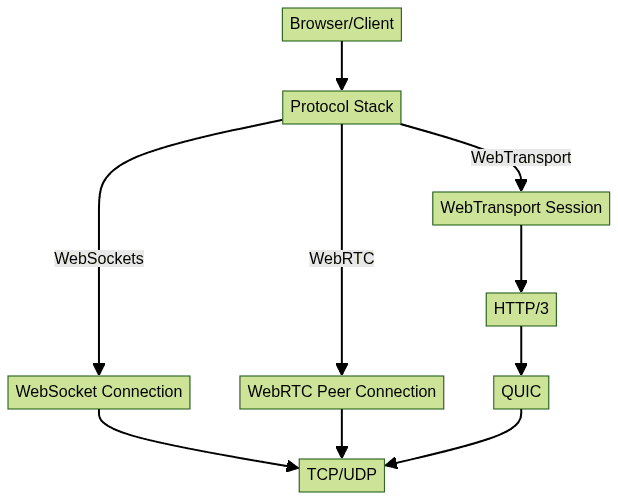Introduction to Node.js WebTransport
Real-time communication is a cornerstone of modern web applications, enabling features like live collaboration, instant messaging, multiplayer gaming, and real-time analytics. As user expectations for responsiveness and interactivity soar, developers seek cutting-edge technologies to deliver seamless experiences. Node.js has long been a top choice for building scalable backends, and with the advent of WebTransport, it now stands on the brink of a new era in real-time communication.
Node.js WebTransport is an emerging protocol designed to overcome the limitations of legacy solutions like WebSockets and WebRTC. Offering low-latency, bidirectional communication over HTTP/3 and QUIC, WebTransport introduces advanced support for streams and datagrams, making it highly suitable for demanding real-time applications. In this comprehensive guide, we'll explore how Node.js WebTransport is shaping the future of web communication, its protocol foundations, the current ecosystem, implementation patterns, practical use cases, and what developers should know about its limitations and production readiness in 2025.
Understanding the WebTransport Protocol
What is WebTransport?
WebTransport is a modern web protocol that offers secure, low-latency, bidirectional communication between clients (usually browsers) and servers. Built on top of HTTP/3 and QUIC, it provides flexible transport capabilities such as session-based communication, unidirectional and bidirectional streams, and datagrams for efficient message transfer.
Core Concepts:
- Sessions: A persistent context for all communication between client and server.
- Streams: Independent, ordered byte streams. Unidirectional streams flow one way; bidirectional streams support two-way communication.
- Datagrams: Lightweight, unreliable messages similar to UDP packets—ideal for real-time use cases where occasional packet loss is acceptable.
How does WebTransport differ from WebSockets and WebRTC?
- WebSockets: Offers a persistent, bidirectional socket over TCP, but lacks built-in support for streams/datagrams and suffers from head-of-line blocking.
- WebRTC: Primarily designed for peer-to-peer media, with complex setup and NAT traversal challenges. For developers working on mobile platforms, exploring
webrtc android
andflutter webrtc
can provide additional insights into real-time communication on Android and Flutter. - WebTransport: Combines the best of both—multiplexed streams, datagrams, low-latency, and server-client focus—making it highly relevant for Node.js WebTransport implementations.
How WebTransport Works with HTTP/3 and QUIC
WebTransport is closely tied to HTTP/3 and the QUIC protocol. QUIC, a modern transport protocol built over UDP, addresses many TCP shortcomings like head-of-line blocking, slow startup, and connection migration. HTTP/3 leverages QUIC to offer reliable, multiplexed communication for web applications.
WebTransport inherits these advantages, enabling:
- Reduced latency via UDP-based QUIC transport
- Multiplexing for simultaneous streams without interference
- Improved reliability and connection management

Node.js WebTransport Support and Ecosystem
Current State of Node.js WebTransport
As of 2025, native Node.js WebTransport support is still evolving. While the official Node.js core does not yet provide first-class WebTransport APIs, experimental modules and community-driven libraries are filling the gap. Notable among these is
@fails-components/webtransport, which implements server and client utilities for WebTransport atop Node.js, albeit with experimental status.Key points:
- Node.js WebTransport support is not yet stable or widely adopted in core; most solutions depend on experimental libraries.
- Community modules like
@fails-components/webtransportand similar projects are driving early adoption and feedback. - Ongoing developments: As browser support matures, expect Node.js WebTransport libraries to stabilize and expand feature sets.
For developers seeking to integrate advanced communication features, solutions like the
javascript video and audio calling sdk
andreact video and audio calling sdk
offer robust APIs for building real-time applications with Node.js and popular frontend frameworks.WebTransport in Socket.io and Other Tools
Socket.io, a popular Node.js real-time framework, has started exploring WebTransport as a transport layer in its experimental branches. While not yet available in mainstream releases, this work signals growing interest in leveraging WebTransport for scalable, low-latency communication.
Alternatives and Workarounds:
- While waiting for mature support, many developers continue to use WebSockets or HTTP/2-based solutions for real-time needs. For those looking to quickly add communication features, using an
embed video calling sdk
can be a fast and effective approach. - For cutting-edge projects, experimenting with Node.js WebTransport libraries is possible, but production use demands caution.
Implementing WebTransport in Node.js
Setting Up a Node.js WebTransport Server
Implementing a Node.js WebTransport server involves several steps. While native support is limited, you can use experimental libraries such as
@fails-components/webtransport to get started.Step 1: Install Required Packages
1npm install @fails-components/webtransport
2Step 2: Create a Basic WebTransport Server
1const { WebTransportServer } = require("@fails-components/webtransport");
2
3const server = new WebTransportServer({
4 port: 4433,
5 cert: "./cert.pem",
6 key: "./key.pem"
7});
8
9server.on("session", (session) => {
10 console.log("New WebTransport session");
11
12 session.on("stream", (stream) => {
13 // Handle incoming bidirectional stream
14 stream.on("data", (chunk) => {
15 console.log("Received:", chunk.toString());
16 stream.write("Echo: " + chunk);
17 });
18 });
19
20 session.on("datagram", (datagram) => {
21 console.log("Datagram received:", datagram.toString());
22 session.sendDatagram(Buffer.from("Ack: " + datagram));
23 });
24});
25
26server.listen(() => {
27 console.log("Node.js WebTransport server listening on port 4433");
28});
29This example demonstrates a minimal Node.js WebTransport implementation, echoing data over streams and acknowledging datagrams. In production, you should manage TLS certificates, handle errors, and scale the server as needed.
Creating a WebTransport Client
WebTransport is natively supported in modern browsers (like Chrome, Edge; with Firefox and Safari catching up). A simple browser client connecting to your Node.js WebTransport server looks like this:
1const transport = new WebTransport("https://localhost:4433");
2
3await transport.ready;
4
5// Create a bidirectional stream
6const stream = await transport.createBidirectionalStream();
7const writer = stream.writable.getWriter();
8const reader = stream.readable.getReader();
9
10await writer.write(new TextEncoder().encode("Hello from client!"));
11
12const { value } = await reader.read();
13console.log(new TextDecoder().decode(value));
14
15// Send a datagram
16const datagramWriter = transport.datagrams.writable.getWriter();
17await datagramWriter.write(new TextEncoder().encode("Quick datagram message"));
18You can also use Node.js-based clients with compatible libraries, though browser support is more mature. For mobile and cross-platform needs, options like
react native video and audio calling sdk
provide seamless integration for real-time features in React Native apps.Handling Streams and Datagrams
WebTransport's most powerful feature is its support for both streams and datagrams. Streams are ideal for ordered, reliable data, while datagrams suit scenarios where speed is essential and occasional loss is acceptable.
Bidirectional Stream Example:
1// Server side: handle incoming stream
2session.on("stream", (stream) => {
3 stream.on("data", (chunk) => {
4 // Process data
5 });
6 stream.write("Response data");
7});
8Sending a Datagram:
1// Client side: send a datagram
2const datagramWriter = transport.datagrams.writable.getWriter();
3await datagramWriter.write(new TextEncoder().encode("Ping"));
4Receiving a Datagram:
1// Server side: receive a datagram
2session.on("datagram", (datagram) => {
3 console.log("Datagram received:", datagram.toString());
4});
5
This dual support empowers Node.js WebTransport implementations to optimize for a wide array of real-time patterns. For applications requiring advanced features like conferencing or live events, leveraging a
Live Streaming API SDK
can further enhance your real-time capabilities.Use Cases and Benefits of Node.js WebTransport
Node.js WebTransport unlocks new possibilities for developers building:
- Real-time multiplayer games: Seamless, low-latency action with flexible data transport (using both streams and datagrams).
- Media streaming: Adaptive, reliable delivery of media chunks, with fast error recovery and minimal buffering. Developers can also benefit from a
Video Calling API
to integrate robust video communication features. - IoT and sensor networks: Efficient, scalable communication with devices where packet loss is tolerable.
- Push notifications and updates: Reliable delivery of real-time alerts to browsers and apps. For voice-based solutions, exploring a
phone call api
can help you implement high-quality audio calling features.
Performance, Scalability, and Low-Latency:
- Multiplexed streams eliminate head-of-line blocking
- Datagrams enable ultra-fast, connectionless messaging
- Built on QUIC for faster handshake and connection migration
The versatility of Node.js WebTransport makes it attractive across industries, from gaming and media to enterprise collaboration and IoT. By leveraging the protocol's strengths, Node.js developers can deliver robust, future-proof solutions.
Limitations, Challenges, and Future Outlook
Despite its promise, Node.js WebTransport faces some notable hurdles in 2025:
- Limited server support: Node.js core lacks native WebTransport APIs; reliance on experimental libraries is necessary.
- Browser compatibility: While Chrome and Edge lead the way, other browsers are catching up.
- Production readiness: Most Node.js WebTransport implementations are not yet considered stable for mission-critical deployments.
However, as browser and server support matures, and as the Node.js community invests in official APIs and powerful libraries, the future of Node.js WebTransport looks bright. Expect rapid improvements, more robust modules, and broader adoption in the coming years.
Conclusion
Node.js WebTransport is redefining real-time, low-latency communication for the next generation of web applications. By harnessing HTTP/3, QUIC, and advanced transport capabilities, Node.js developers can build faster, more scalable, and more interactive solutions. While tooling and support are still evolving, early adopters are already pushing the boundaries of what's possible. If you're building for the real-time web, keep a close eye on Node.js WebTransport as it matures in 2025 and beyond. To experience these capabilities firsthand,
Try it for free
and start building your next-generation real-time application today.Want to level-up your learning? Subscribe now
Subscribe to our newsletter for more tech based insights
FAQ